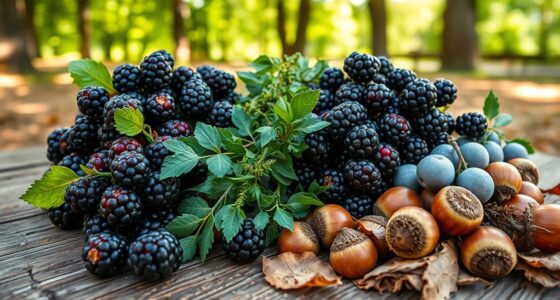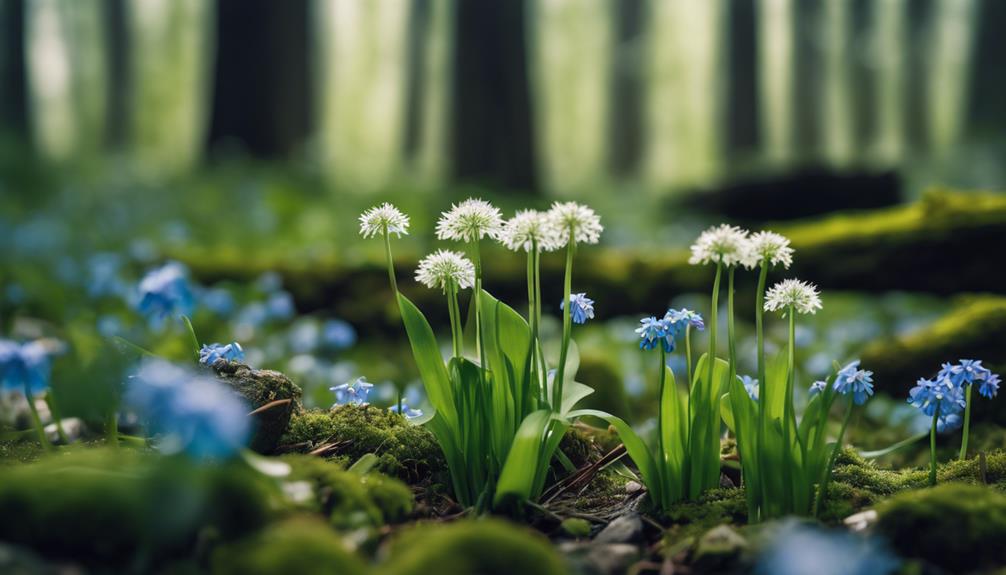You can forage for pine nuts in the wild, specifically in regions like the Sierra Nevada, Southern California, Nevada, and Utah, where pine trees like Pinus edulis and Pinus monophylla grow, offering a accessible and free source of this nutritious and versatile ingredient. Look for slightly open cones as a sign of maturity, and harvest during late summer to early fall when cones are fully ripe. With the right techniques and conditions, you can efficiently gather and store pine nuts, revealing their nutritional benefits and culinary potential. Now, uncover the secrets of foraging and preparing pine nuts like a pro!
Key Takeaways
- Pine nuts can be foraged from pine cones of species like Pinus edulis and Pinus monophylla in regions like Sierra Nevada and Southern California.
- Ideal harvesting times are late summer to early fall when cones are fully matured and partially open, indicating ripe pine nuts.
- Efficient harvesting involves using gloves and a basket, twisting mature cones off the branch, and storing them in a cool, dry place.
- Pine nuts can be processed and stored by shelling each nut individually and storing them in airtight containers in a cool, dark place.
- Foraging for pine nuts can be time-consuming and physically demanding, leading to a new appreciation for store-bought options.
Where to Find Pine Nuts
You can find pine nuts in pine cones from species like Pinus edulis in the Southwest and Pinus monophylla in the Great Basin region. These species are ideal for foraging, and knowing where to look is important.
When searching for pine nuts, head to areas like Sierra Nevada, Southern California, Nevada, and Utah. These regions offer abundant opportunities to find the perfect pine cones. Look for pine trees with cones that are slightly open, as this indicates they're mature and ready for harvesting.
Remember, it's vital to identify the right species, as not all pine trees produce edible nuts. By targeting the correct regions and species, you'll increase your chances of finding high-quality pine nuts.
With the right location and species, you'll be well on your way to foraging delicious and nutritious pine nuts.
Ideal Harvesting Times and Conditions

Now that you've identified the right species and locations, it's time to contemplate the ideal harvesting times and conditions to guarantee you're collecting high-quality pine nuts.
The best time to forage pine nuts is in late summer to early fall, when the cones are fully matured and ready for harvesting. Look for partially open cones that have turned brown, indicating ripe pine nuts ready for collection.
Avoid harvesting in wet conditions, as this can affect the quality and shelf life of the nuts. Instead, wait for ideal harvesting times when cones exhibit specific characteristics like firmness, color, resin presence, and a distinct sound when tapped.
Make sure cones are fully dried and matured before extracting and storing the pine nuts for the best flavor and longevity.
Techniques for Efficient Harvesting

To maximize your harvesting efficiency, gather a few essential tools, including gloves to protect your hands from the prickly pine cones and a basket or tarp to collect the cones. This will guarantee you time and energy in the long run.
When you're ready to harvest pine, look for mature cones that are brown and open. Use your gloved hands to twist them off the branch, taking care not to damage the pine tree. Avoid pulling or yanking, as this can harm the tree and reduce future yields.
Collect the cones in your basket or tarp, and store them in a cool, dry place to make sure they fully mature. This will make it easier to extract the pine nuts later. Remember to handle the cones gently to avoid damaging them, as this can affect the quality of the nuts.
Processing and Storing Pine Nuts

Extracting the nuts efficiently from your freshly harvested pine cones stored in a cool, dry place is vital for preserving their flavor and quality. To do this, you'll need to shell each pine nut individually, ensuring each nut is properly extracted. This might be time-consuming, but it's valuable for the best results.
Once you've extracted the pine nuts, it's important to store them correctly to maintain their freshness. You can store them in airtight containers in a cool, dark place to prevent spoilage. For long-term storage, consider freezing them, which can extend their shelf life for over two years.
Don't forget to repurpose the leftover pine nut shells – you can use them to make pine nut bourbon, reducing waste and adding flavor.
Nutritional Benefits of Pine Nuts

As you learn about the nutritional benefits of pine nuts, you'll discover that they're a treasure trove of goodness. Rich in antioxidants, they'll help protect your brain and body from damage, and their protein content makes them a great addition to a weight management plan.
Now, let's take a closer look at the specific benefits you can reap from incorporating pine nuts into your diet.
Rich in Antioxidants
Pine nuts bring a powerful antioxidant punch to your diet, fighting off cell damage and oxidative stress with their rich stores of vitamins E and K. As you incorporate pine nuts into your meals, you'll be supplying your body with a robust defense against free radicals, which can cause harm to your cells and contribute to chronic diseases.
The antioxidants in pine nuts don't just stop at cell protection, though – they also have anti-inflammatory properties, which can help reduce your risk of chronic diseases like heart disease and cancer.
When you snack on pine nuts, you're not only getting a dose of antioxidants, but also essential nutrients like vitamins E and K, which support overall health and well-being. These nutrients work together to boost your heart health by reducing cholesterol levels and improving blood circulation.
Plus, pine nuts are a great source of healthy fats, protein, and energy-boosting properties, making them a nutritious and filling addition to your diet. By adding pine nuts to your meals, you'll be giving your body the tools it needs to thrive.
Brain Health Benefits
You can support your brain health by incorporating pine nuts into your diet, as they're packed with nutrients that enhance cognitive function and overall mental well-being.
Rich in magnesium, vitamin E, and antioxidants, pine nuts provide a powerful boost to your brain's performance.
The omega-3 fatty acids present in pine nuts have been shown to improve cognitive function and memory, making them an excellent addition to a brain-healthy diet.
Furthermore, the fatty acids in pine nuts help reduce inflammation in the brain, promoting overall cognitive well-being.
By consuming pine nuts, you can expect improved mood and mental clarity, making them an excellent snack for students, professionals, or anyone looking to improve their mental performance.
Including pine nuts in your diet can also support brain function and may even help protect against age-related cognitive decline.
With their rich nutritional profile, pine nuts are an excellent way to support your brain health and overall well-being.
Protein Content Matters
With a whopping 3.9 grams of protein per ounce, pine nuts stand out as a notable plant-based protein source that can elevate your diet in a multitude of ways.
As a complete protein source, pine nuts contain all nine essential amino acids, making them an excellent addition to your meals.
You'll benefit from incorporating pine nuts into your diet, as they can support muscle growth and repair. The protein content in pine nuts can also aid in weight management by promoting feelings of fullness, reducing the likelihood of overeating.
Moreover, adding pine nuts to your meals can enhance the overall nutritional value and contribute to a balanced diet. By including pine nuts in your diet, you'll not only boost your protein intake but also reap the benefits of a nutrient-dense food.
Recipes Featuring Pine Nuts

You're now ready to explore the culinary side of pine nuts, and you'll be excited to try out these creative recipes.
From the rich flavors of Pine Nut Pesto Delight to the crunchy textures of Savory Salad Inspiration and Crunchy Baked Goods, you'll discover how pine nuts can elevate your cooking.
Get ready to experiment and find your new favorite dishes!
Pine Nut Pesto Delight
Incorporating pine nuts into your pesto recipes adds a rich, nutty flavor and a satisfying crunch that elevates any dish. You can take your pesto game to the next level by using toasted pine nuts, which enhance their taste and aroma. The result is a sauce that's both flavorful and nutritious.
You can use your pine nut pesto as a pasta sauce, dip, or spread for sandwiches – the possibilities are endless! The key to making a great pine nut pesto is to balance the flavors. Combine toasted pine nuts with fresh basil, garlic, Parmesan cheese, and a squeeze of lemon juice for a delicious and versatile sauce. You can also experiment with different ingredients to create unique flavor profiles.
With pine nut pesto, you can add a touch of elegance to any meal. So, get creative and start experimenting with pine nuts in your pesto recipes today!
Savory Salad Inspiration
Pine nuts' versatility in pesto recipes naturally lends itself to exploring their role in other dishes, like savory salads, where their crunchy texture and nutty flavor can elevate a variety of ingredients.
As you experiment with pine nuts in salads, remember they add a delicate crunch and buttery flavor, enhancing the taste and texture of your creations.
Here are three ways to incorporate pine nuts into your salads:
- Mediterranean Mix: Combine pine nuts with feta cheese, olives, cucumbers, and a drizzle of balsamic vinaigrette for a revitalizing and flavorful salad.
- Fresh Fusion: Pair pine nuts with mixed greens, sliced apples, and crumbled blue cheese for a sweet and savory combination.
- Veggie Delight: Toss pine nuts with roasted vegetables, mixed greens, and a zesty vinaigrette for a nutritious and filling salad.
Crunchy Baked Goods
Add a delightful twist to your baked goods by introducing pine nuts, which bring a satisfying crunch and rich, nutty flavor to treats like cookies, cakes, and bread. You'll be surprised at how easily pine nuts elevate the texture and richness of your baked goods.
Try incorporating them into traditional recipes like Italian biscotti or Greek koulourakia for an authentic twist. Pine nuts will enhance the flavor profile of your pastries, providing a nutty and buttery taste that's sure to impress.
Experiment with different recipes and ratios of pine nuts to flour to find your perfect combination. Remember, pine nuts can be toasted or used raw, so don't be afraid to get creative!
With their unique flavor and crunchy texture, pine nuts are the perfect addition to take your baked goods from ordinary to extraordinary. So go ahead, get baking, and discover the delightful difference pine nuts can make!
Troubleshooting Common Challenges

You'll often find that extracting pine nuts can be a painstaking process, especially when dealing with their tiny size. Harvesting pine nuts is a time-consuming and tedious task, and it's no wonder that store-bought pine nuts come at a high price. The labor-intensive process of harvesting them is reflected in their cost.
As you forage for pine nuts, you may encounter some common challenges. Here are a few to watch out for:
- Tiny size: Pine nuts are small, making them difficult to extract from their shells.
- Time-consuming process: Harvesting pine nuts requires patience and dedication, as it can be a slow and tedious process.
- Labor-intensive: The process of harvesting pine nuts is physically demanding, requiring a significant amount of effort and energy.
After attempting to forage pine nuts, you may develop a new appreciation for the convenience and value of store-bought pine nuts. Despite the challenges, many people find the experience of foraging for pine nuts to be rewarding, even if they don't plan to repeat it.
Frequently Asked Questions
Can You Forage Pine Nuts?
Foraging pine nuts requires identifying the right pine tree species and mastering the harvesting technique to collect mature cones and extract the nuts sustainably.
How to Find Pine Nuts in the Wild?
What a coincidence that you're searching for pine nuts in the wild! You'll find them in regions like the Southwest and Great Basin, particularly under Pinus edulis and Pinus monophylla trees, usually in early August.
Can You Get Pine Nuts From Ponderosa Pine?
You're wondering if you can get pine nuts from Ponderosa pine? Yes, you can! Ponderosa pine trees produce edible nuts, but be prepared to put in the effort to extract them from their thick, rigid cones.
Where to Harvest Pine Nuts in Utah?
Are you ready to forage like a pro? In Utah, you'll find pine nuts galore under Pinion Pine trees in areas like Provo, Rock Canyon, and Squaw Peak – perfect for a self-harvesting adventure!
Conclusion
You've made it through the pine nut foraging guide – congratulations! You now know where to find, how to harvest, and what to do with those delicious little treasures. With your newfound skills, consider adding pine nuts to your collection of **prepper food pantry essentials**. Their long shelf life when stored properly and high nutritional value make them perfect for both everyday meals and emergency situations. Whether you’re making pesto, sprinkling them on salads, or simply enjoying them roasted, these foraged gems will be a staple you’ll always appreciate. Building a prepper food pantry with nutrient-packed, versatile ingredients like pine nuts ensures you’re prepared for any situation, whether it’s a sudden emergency or just busy weeknights. Their rich content of healthy fats, protein, and essential minerals will help sustain you and your loved ones for the long haul. Don’t overlook the value of having such a robust, natural food source in your pantry—it’s a small addition with significant benefits that can enhance both flavor and nutrition.
But let's be real, you're probably still going to end up with pine sap on your clothes and a few bruised fingers. It's all worth it, though, for that perfect pesto or salad topping.
Happy foraging!










